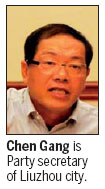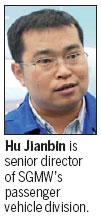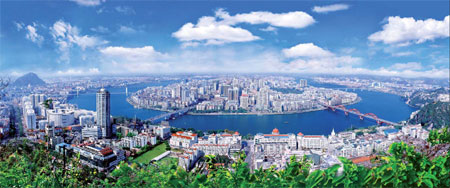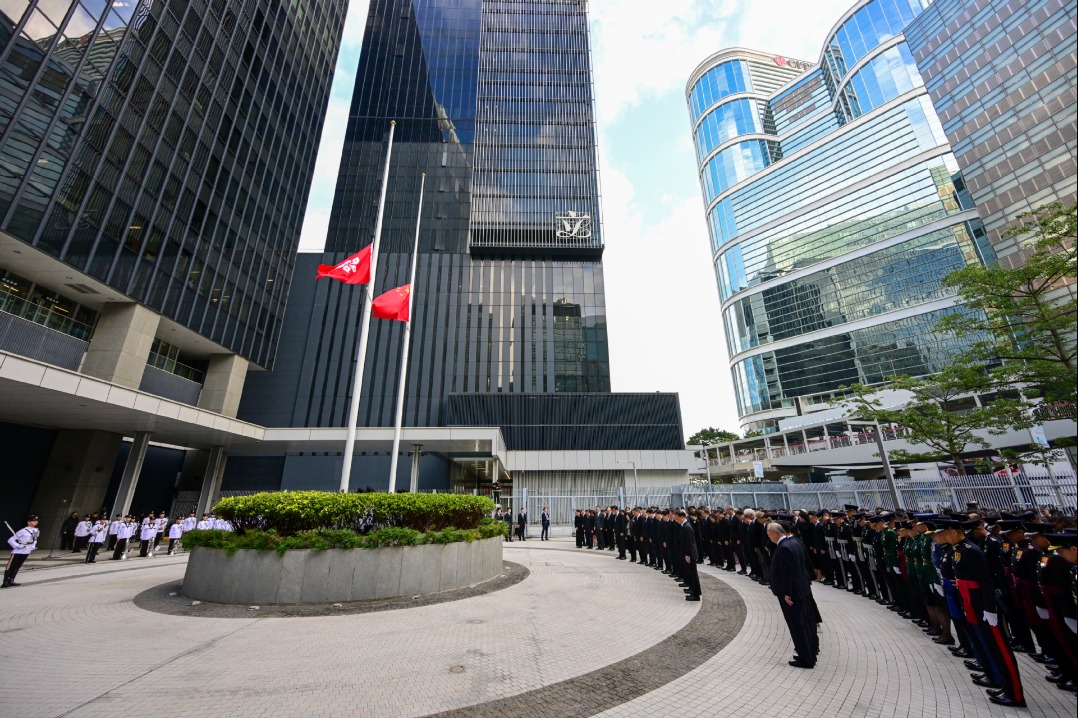City defies the slowdown

| Liuzhou, in South China's Guangxi Zhuang autonomous region, is home to 460 vehicles and parts manufacturers, generating an output of 116 billion yuan last year. He Xiaohua / for China Daily |
A city in Guangxi has proven that it can continue to make and sell autos despite the industry's malaise
While China's auto market has slowed drastically from its heydays of less than two years ago - it grew 45 percent in 2009 and 32 percent in 2010 - at least one city in Guangxi Zhuang autonomous region has weathered the storm. Liuzhou, a landlocked city in South China, was once widely known for its Phoebe timber used to make coffins. As they used to say in the city, "born in Hangzhou, dine in Guangzhou, and die in Liuzhou". But the city, with a population of 3.75 million located approximately 250 km from the provincial capital of Nanning, has over the past decade resurrected its economy with its numerous factories producing cars, trucks, sport-utility vehicles and auto parts.
In 1969, when Liuzhou produced its first car, its primary economic drivers were still timber and handicrafts. Today, it is dominated by the auto industry, followed closely by the machinery and metallurgy industries. Liuzhou Party secretary Chen Gang recently said the city's auto industry is "flying high against the wind".

Last year, 460 vehicles and parts manufacturers called Liuzhou home, generating output of 116 billion yuan ($18.6 billion; 14.4 billion euros). Combined, they account for 40 percent of the total industry output in Liuzhou, according to the Liuzhou Commission of Industry and Information Technology. Altogether, 86,000 people work in auto-related businesses in the city.
The city government anticipates that the production capacity of vehicles will reach 1.6 million units by the end of this year, with output reaching 130 billion yuan.
Liuzhou's biggest moneymaker is the minivan. Nearly 50 percent of China's minivans are produced in the city. SGMW, a three-shareholder joint venture between SAIC Motor Corp, Liuzhou Wuling Motors Co and GM China, is located in Liuzhou and has sold the most minivans in China for the past seven years. This year marks the 10th anniversary of the SGMW joint venture and within that time, the company's production volume (of mostly minivans) has grown from 140,000 units to a staggering 1.4 million.
Another car model, the multiple-purpose vehicle - which is similar to the Buick GL8 and contains five to seven adjustable seats - is becoming increasingly important for the city's economy. MPVs produced in Liuzhou account for nearly 30 percent of the national market, ranking the city as the top MPV-maker nationally since 2010.
During the first nine months of this year, companies in Liuzhou sold 1.2 million vehicles, a 13-percent increase from the previous year.
Just how productive has Liuzhou's auto industry been? Here are some more statistics for you: Production capacity in the city, over the past five years, doubled. Output in that period soared by 140 percent. It is currently producing nearly 8.5 percent of the nation's cars despite China's sluggish auto sales, which slowed to a 3.7-percent growth rate in August.
Though most of Liuzhou's auto companies are home-grown, SGMW is clearly the strongest. Its sales figures and production capacity, many industry analysts say, is the barometer for the Chinese auto industry.
In 2009, the company's sales figures exceeded a million units, a 65-percent growth from the previous years largely because of government policies that included tax incentives and subsidies for rural buyers. When the government cancelled the incentives in 2011, the auto market quickly tapered. SGMW, however, has persisted.
Hu Jianbin, the senior director of SGMW's passenger vehicle division, says companies should not rely on government incentives, although he admits that the subsidies did significantly stimulate sales for the company.

As part of its efforts to be self-sufficient from government policies, SGMW is actively introducing different auto models, including the compact MPV called the Wuling Hongguang, which costs between 45,000 yuan and 72,000 yuan.
"When people get richer, they need to trade up for higher-end vehicles and the Wuling Hongguang fits into this niche market," says Hu, who adds that this year SGMW expects to deliver 350,000 units of the Wuling Hongguang.
A sedan called the Baojun is also among the newest additions to the company's portfolio. Last year, sales of Baojun ranked fourth among sales of sedans for Chinese automakers. The sticker price is 63,000 yuan to 96,000 yuan.
Thanks in part to sales of Wuling Hongguang and Baojun, SGMW delivered 1.2 million vehicles between January and October, up 14 percent from the previous year.
But success in Liuzhou has been mainly through the sales of passenger vehicles. The market for commercial vehicles, which include trucks among others, is an entirely different story.
Dongfeng Liuzhou Motor Co, a major commercial vehicle manufacturer, last year predicted that its truck sales would drop 50 percent from 60,000 units last year to 30,000 units this year as a result of shrinking demand.
To combat the sluggish market for commercial vehicles, Liuzhou Motor is improving the fuel efficiency of its commercial vehicles to meet government requirements and also exploring new markets.
Huang Ziqiang, deputy general manager of Liuzhou Motor, says demand for trucks in China is saturated and the company is looking to export trucks to Southeast Asia, Africa and South America.
The company's bread and butter, however, is the passenger car sector, which is expected to raise production capacity to 180,000 units by 2017. Last year, sales of passenger cars contributed half of the company's 12.7 billion yuan in revenue.
"Hopefully we can take 8 percent of the Chinese commercial vehicle market and 1 to 2 percent of the Chinese passenger car market by then," Huang says.
MPVs produced by Liuzhou Motor is another bright spot for the company. With a delivery of 65,551 units through November of this year, Liuzhou Motor is now the top MPV manufacturer in China. Next year, it plans to launch another MPV model targeting private entrepreneurs.
But Liuzhou is not just filled with auto manufacturers. Its success in selling autos has been a boon to auto parts makers.
Xiong Shaofei, vice-chairman of Guangxi Fangsheng Group, a local parts company, says the local automakers have offered them a shelter in the bad market climate.
"Liuzhou has several important auto companies including SGMW, Liuzhou Motor and Liugong Machinery Co, which lend plenty of room for our sales," he says.
Fangsheng Group is a major axle and mold manufacturer in Liuzhou. In 2011, the company earned 40 billion yuan; Xiong estimates this year will close with similar revenue figures.
But Huang says auto parts companies have to upgrade their product lines.
"Currently, most companies depend on cheap labor and are still expanding at a low level," he says.
The key for Fangsheng is the bus sector. After collaborating with a South Korean axle company affiliated with Hyundai, Huang says that its products have seized more than 60 percent of the long-bus market (buses longer than 11 meters). Major bus companies including Yutong and Golden Dragon are using axles produced by Fangsheng.
But Fangsheng still needs to purchase key components from foreign companies, Xiong says.
"With labor costs rising fast, we face a slimmer and slimmer profit margin in the future," he says.
Xiong says the company is now investing 1-4 percent of its annual revenue into its axle division. The company is also helping clients design their own molds, a departure from previous years of casting molds for automakers.
"We cannot always compete at the bottom level of the value chain," Huang says. "That's why we partnered with Hyundai axle affiliate, because we don't have enough time to start from scratch."
Innovation and new research and development efforts are not, however, just limited to the city's automakers and auto parts manufacturers. Officials with the Liuzhou government say there isn't room for more auto companies or the expansion of existing ones. It is in the process of building an "auto city" to house major auto companies, fitting them with schools, manufacturing plants, dormitories and office space in Liuzhou's suburban areas. The government is investing 20 billion yuan in the project.
An area of 203 square kilometers is planned for the new auto city. By 2015, it is predicted the auto city will have a combined production capacity of 1 million vehicles per year.
Since 2009, when plans for the auto city were put into effect, the so-called auto city has given a glimpse of what it will look like. From its origins as a vast land of sugarcanes, numerous buildings and plants have been erected through November.
The government also requires that companies move their research and development divisions to the auto city in an effort to make it more than just a manufacturing site. SGMW has already moved more than 3,000 R&D researchers to the site.
He Huanquan, head of the auto city management committee, says adequate talent supply is crucial for auto companies to develop further. The Liuzhou government has planned a campus area of up to 1,000 hectares to accommodate four schools, including universities and vocational schools.
The committee also signed an agreement with Oxford University, pledging to introduce 50 European auto companies in the next five years.
"Supply chains are essential for auto companies. As SGMW decided to build another manufacturing center, more than 50 parts companies have decided to follow up," he says.
The government plans to invite service companies to the auto city, including a test and inspection center to supervise product quality.
"Auto financing is still in its infancy, but the government is talking with banks to set up auto development funds to help auto parts startups."
Contact the writers at wangchao@chinadaily.com.cn and huoyan@chinadaily.com.cn
Huang Feifei in Nanning contributed to this story.
(China Daily 12/28/2012 page16)
Today's Top News
- Xi stresses improving long-term mechanisms for cyberspace governance
- Experts share ideas on advancing human rights
- Japan PM's remarks on Taiwan send severely wrong signal
- Key steps to boost RMB's intl standing highlighted
- Sustained fight against corruption urged
- Xi calls for promotion of spirit of volunteerism































